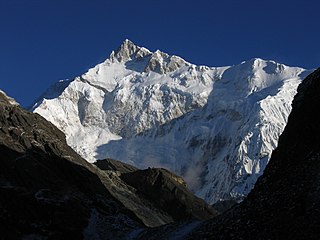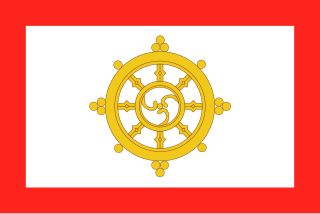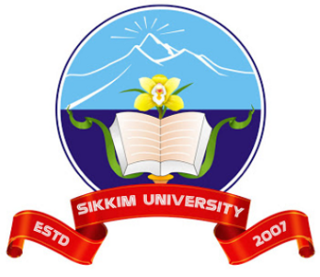
Gangtok is a city, municipality, the capital and the largest town of the Indian state of Sikkim. It also is the headquarters of the East Sikkim district. Gangtok is located in the eastern Himalayan range, at an elevation of 1,650 m (5,410 ft). The town's population of 100,000 are from different ethnicities such as Nepalis, Lepchas and Bhutia. Nestled within higher peaks of the Himalaya and enjoying a year-round mild temperate climate, Gangtok is at the centre of Sikkim's tourism industry.

Sikkim is a state of India. It is a center for western-style music in India, and has been since the rise of bands like Orchids and Naren Rasaily's Flickers, beginning in 1968. The band performed at many competitions, occasions and venues.
Sikkim is largely Nepali and popular Nepali singers Bejamin Rai, and Sukmit Lepcha are followed. Another popular act is Sikkim's Star.

The history of Sikkim an area in present-day North-East India, began in 1642 as a kingdom established when India and Nepal were still many princely states with many rulers at that time and had not unified to the present Union of India and present country of Nepal. At that time Sikkim had already solidified into country then with a king known as a Chogyal or dharma king, and till 16 May 1975 was an independent country ruled by the monarchs. Sikkim had twelve kings; Palden Thondup Namgyal was the last king of Independent Sikkim. There was contacts between ancient Hindus and Tibetans, followed by the establishment of a Buddhist kingdom or Chogyal in the 17th century. Sikkim emerged as a polity in its own right against a backdrop of incursions from Tibet and Bhutan, during which the kingdom enjoyed varying degrees of independence. In the early 18th century, the British Empire sought to establish trade routes with Tibet, leading Sikkim to fall under British suzerainty until independence in 1947. Initially, Sikkim remained an independent country, until it merged with India in 1975 after a decisive referendum. Many provisions of the Indian constitution had to be altered to accommodate the international treaties between Sikkim and India.

South Sikkim is a district of the Indian state of Sikkim. Its capital is Namchi.

Khecheopalri Lake, originally known as Kha-Chot-Palri, is a lake located near Khecheopalri village, 147 kilometres (91 mi) west of Gangtok in the West Sikkim district of the Northeastern Indian state of Sikkim.

Khangchendzonga National Park also Kanchenjunga Biosphere Reserve is a National Park and a Biosphere reserve located in Sikkim, India. It was inscribed to the UNESCO World Heritage Sites list in July 2016, becoming the first "Mixed Heritage" site of India. The park gets its name from the mountain Kangchenjunga which is 8,586 metres (28,169 ft) tall, the third-highest peak in the world. The total area of this park is 849.5 km2 (328.0 sq mi).

The Sikkim Police is the law enforcement agency of the government of Sikkim in India. It employs a large number of people to patrol the streets. It is headquartered in the state capital Gangtok. The Sikkim police is headed by a Director General of Police and falls under the purview of the state Home Department. Sikkim in general has a low crime rate. In March 2007 there was a fratricidal incident involving Sikkim Police detachment protecting a bank in Delhi. One jawan was accused of murdering five of his colleagues in retaliation for a sodomy attempt. However the details are unclear.
The administrative divisions of India are subnational administrative units of India; they compose a nested hierarchy of country subdivisions. Indian states and territories frequently use different local titles for the same level of subdivision.

Sikkim Manipal University (SMU) is a funded, co-educational, public-private university in Gangtok, Sikkim, India. Established in 1995, the university is credited as being the first P3 education and health care initiative in the region.

Sikkimese are people who inhabit the Indian state of Sikkim. The dominance ethnic diversity of Sikkim is represented by 'Lho-Mon-Tsong-Tsum' that identifies origin of three races since seventeenth century. The term 'Lho' refers to Bhutias (Lhopo) means south who migrated from southern Tibet, the term 'Mon' refers to Lepchas (Rong) lived in lower eastern Himalayas and the term 'Tsong' refers to Limbus (Tsong) another indigenous tribe of Sikkim. However, Nepali-Indians started to inhabited in Sikkim since the nineteenth century and later the presence of people from mainland India.

The Kingdom of Sikkim, earlier known as Dremoshong, was a hereditary monarchy from 1642 to 16 May 1975 in the Eastern Himalayas. It was ruled by Chogyals of the Namgyal dynasty.
Public Health Engineering Department (PHED) is a department of the Government of Sikkim that looks after several civic utilities of the Indian state of Sikkim, including water supply to urban areas such as the capital Gangtok.

Sikkim University is a central university established under an Act of Parliament of India. It is in Gangtok. The campus is expected to be built at Yangang in South Sikkim district, about 56 kilometres (35 mi) from Gangtok. Its first chancellor was M. S. Swaminathan; Mahendra P. Lama was the first vice chancellor.

Prem Das Rai is an Indian politician from the Sikkim Democratic Front (SDF) party. Mr. Rai is currently a Member of Parliament from the Sikkim constituency of Sikkim, India, first elected in 2009 election and re-elected in 2014 after serving his first term in 2009-2014.
Lachen Monastery, built in 1858, is a Nyingma Buddhist monastery near Lachen, Sikkim, northeastern India.

The National Institute of Technology Sikkim, commonly referred to as NIT Sikkim or NIT SKM, is a public engineering institution near the city of Ravangla in Sikkim, India. It is one of the 31 National Institutes of Technology in India and has been declared as an Institute of National Importance by the Government of India. It is an autonomous institute and functioning under the aegis of Ministry of Human Resource Development, Government of India.

The election was held on 12 April 2014 for 7th assembly of Sikkim, the northeastern state of India. It elected 32 members of Sikkim Legislative Assembly.
Pawan Chamling was elected as Chief Minister of Sikkim for fifth time in May 2014. Here is the list of ministers














